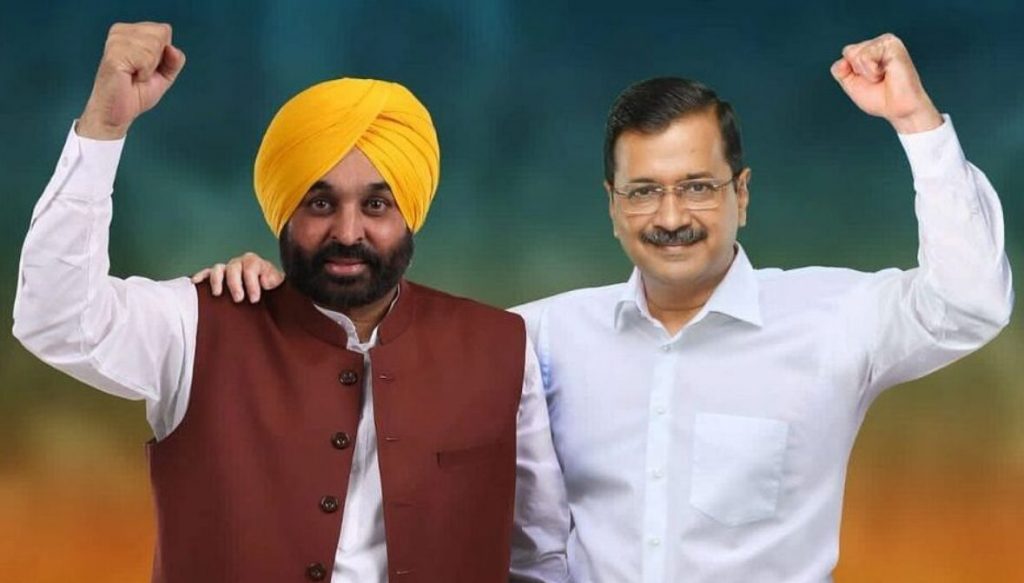The people of Punjab have scripted a new chapter in the history of electoral politics in India by overwhelmingly voting to power the Aam Aadmi Party (AAP) in the recent polls and throwing by the wayside political parties like the BJP, Congress and the Shiromani Akali Dal (SAD). The formation of AAP is an outcome of the common man’s clamour for clean politics and angst against corruption and false promises given by established political parties irrespective of their ideological differences. That voters in Punjab have become sick of the politics of grabbing power for personal and family gains as displayed by other political parties is clear from their preference helping AAP bag 92 of 117 seats and heaping humiliation on the Congress, SAD, BJP, SP and the BSP. The Congress could win only 18 seats against the SAD’s tally of three, BJP’s two and SP and BSP’s one each. The AAP’s tally is a record since the state was formed in 1966. That it could win such trust of the people contesting only for the second time speaks volumes for the mood of the people in the state. AAP’s vote share this time is 42.01 per cent against 23.7 per cent in the 2017 Assembly polls. Congress saw a sharp decline in its vote share dipping from 38.5 per cent to 22.98 per cent, while the SAD’s share dropped from 25.2 per cent in 2017 to 18.38 per cent.
The new tactic adopted by the farmers of Punjab to consciously keep established political parties out of their recent year-long agitation against the three farm laws of the BJP-led government at the Centre appears to have got political legitimacy in the state Assembly polls. The SAD tried to cash in on the farmers’ resentment against the now repealed farm laws by severing its ties with the BJP at the height of the agitation. The Congress also hoped to gain electoral dividends by supporting the agitation. However, the farmers scrupulously spurned overtures from all established parties and remained firm in their resolve not to give in till their demand for scrapping of the laws was conceded. Even during the run-up to the polls, there was speculation whether the Congress and SAD could get farmers on their side. The most telling example of the farmers’ new electoral behaviour in favour of a party that wants to be the voice of the people is the sweeping victory of the APP in the Malwa region which has 69 of the 117 Assembly seats. This massive win of APP is an outright rejection of the duopoly of the Congress and the SAD which have so long been ruling the state by turns. Fed up with caste politics, corruption and nepotism with which the two parties have become synonymous, people probably wanted to let a new party that promises to work for the common man get a turn to rule. Delhi Chief Minister and AAP supremo Arvind Kejriwal’s door-to-door and grassroots campaign also gave more power to the campaign. Interestingly though, the political party formed by the protesting farmers, the Sanyukt Samaj Morcha, failed to win a single seat.
In Punjab, power has alternated between the SAD, which had a 24-year-long partnership with the BJP from 1997 to 2021, and the Congress. The previous Captain Amarinder Singh-led Congress government incurred the wrath of the people by reneging on its promise of cracking down on drug racket allegedly patronised by the SAD during its tenure. Instead of taking action against the Badals of the SAD, it soft-pedalled their alleged involvement. Against this backdrop the AAP’s promise of delivering its electoral pledges resonated with the people. The AAP could establish its credibility with the help of its Delhi model of governance, providing quality government education, health, power and water at cheap rates. A state that had been coughing up inordinately high rates for power, and where health and education are mostly privatised, people responded positively. Women and youth of Punjab also threw their lot in with the AAP with its promise of rooting out corruption and ensuring quality education and employment.
AAP’s promise of depositing a sum of `1,000 per month into the accounts of women in the state helped the party get women’s votes in large numbers. This is an echo of the TMC’s promise of giving West Bengal’s poor women a monthly allowance of `500 each for which the party had reaped rich electoral dividends only a few months back. Moreover, AAP’s promise of giving 300 units of free power to every household that would leave eight out of 10 households with no bills to pay each month, setting up village clinics like the mohalla clinics of Delhi, revamping Punjab’s dilapidated government schools like what has been done in the capital and access to free hospital care have acted like magic for the APP. The people of Punjab probably calculated these are not empty promises as AAP had delivered on them in Delhi. This is in sharp contrast to the failed electoral promises given by traditional ruling parties. The AAP has to deliver on its pledges. If it succeeds, the country’s electoral politics may undergo a much needed transformation so that power does not become the monopoly of some greedy families with their worthless scions or a bunch of power-hungry leaders cozying up to their patrons – corporate big businesses – prospering at the cost of the people.
